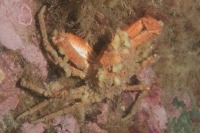
(Photo: Claire Goodwin)
Arctic Lyre Crab
Hyas coarctatus
A red crab with a lyre- or violin-shaped carapace (shell). Carapace length up to 7 centimetres in males and 5 centimetres in females.
Authority
Leach, 1815
Classification Details
Phylum: Arthropoda (arthropods); Subphylum: Crustacea (crustaceans).
Habitat
Found on all types of seabed from 1 to 500 metres. Present all around the Arctic and as far south as North Carolina in the Atlantic and Puget Sound in the Pacific.
Diet
Graze on algae and prey on hydroids, worms, other crustaceans, and molluscs.
Reproduction
Lyre crabs can be male or female. Males mate with females, transferring sperm using modified legs. The female lays her eggs and carries them under her abdomen. She may have up to 8 000 eggs at a time. Around nine to 11 months later, the larvae hatch. They swim in the plankton for two to three months before settling to the seabed.
Fun Facts
Lyre crabs like to decorate their bodies with seaweed and other debris. This helps camouflage them from predators.
References
Anger K (1984). Development and growth in larval and juvenile Hyas coarctatus (Decapoda, Majidae) reared in the laboratory. Marine Ecology Progress Series 19, 115–123. 10.3354/meps019115.
Pohle G (1990) A guide to decapod crustacea from the Canadian Atlantic: Anomura and Brachyura. Canadian Technical Report of Fisheries and Aquatic Sciences 1771.
Pohle G (2011) Larval development of Canadian Atlantic oregoniid crabs (Brachyura: Majidae), with emphasis on Hyas coarctatus alutaceus Brandt, 1851, and a comparison with Atlantic and Pacific conspecifics. Canadian Journal of Zoology 69, 2717–2737. 10.1139/z91–384.


